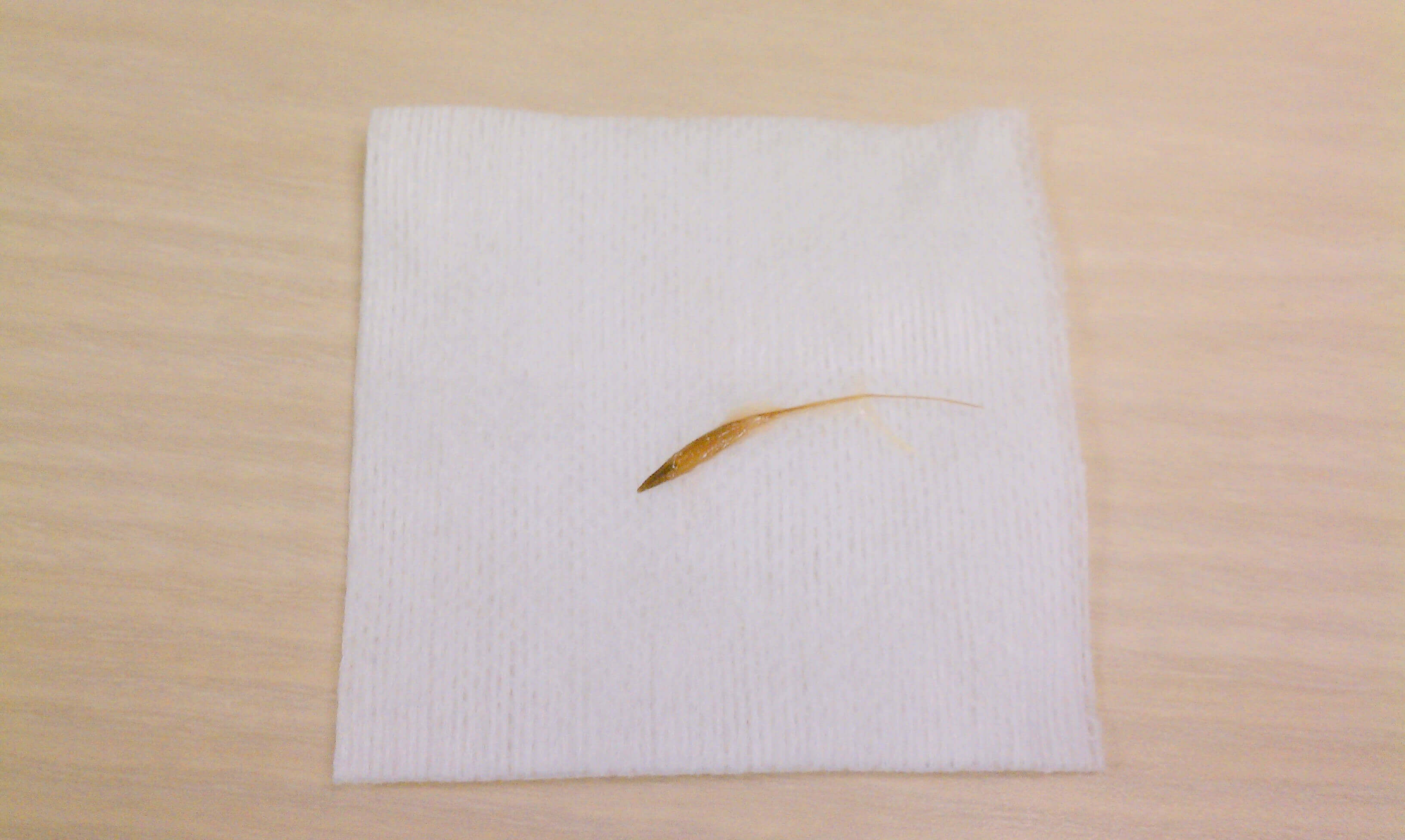Dog Foxtail Symptoms
Foxtails can cause problems for dogs and outdoor cats, and the symptoms of foxtails depend on where on the body the foxtail has burrowed itself:
- Nose foxtails: If the foxtail is located in your dog's nasal passage, they may experience signs that include pawing at the nose, severe sneezing and possible bleeding from the nose. Symptoms sometimes diminish after several hours, becoming intermittent.
- Ear foxtails: If the foxtail is located in your dog's ear canal, they may present signs like tilting and shaking the head, pawing at the ear, crying and moving stiffly.
- Eye foxtails: If the foxtail has ended up under your dog's eyelid or behind the eyeball, they may exhibit signs like squinting the eye, redness, swelling and mucous discharge.
- Throat foxtails: If the foxtail is located in your dog's throat, they may exhibit signs like swallowing repeatedly, stretching the neck, gagging and coughing.
- Feet foxtails: If the foxtail embeds into your dog's feet, they may start licking excessively and show signs of redness of the toe web and possibly a bump or draining tract.
If your pet shows any of the above symptoms of foxtail, schedule an appointment with your veterinarian immediately to get the issue looked at by a professional.
Featured Quote:
These foxtails are everywhere right now. We've had so much great rain, which we appreciate, but it has created a plethora of fox tails everywhere. I want you all to be aware of how dangerous these are for your pets.
Video Transcript:
Hi, this is Dr. Drake, and this is Cici Hamlet, Dr. Hamlet's very cute dog who's a little nervous right now because she's afraid of these things behind me, which are called fox tails. These foxtails are everywhere right now. We've had so much great rain, which we appreciate, but it has created a plethora of fox tails everywhere. I want you all to be aware of how dangerous these are for your pets.
When you're out taking hikes, if you could avoid these at all cost, these terrible little things have this sharp, pointy edge, which it can go in your dog's nose, in their ears, and especially between their toes. The best way to avoid them is to stay on the middle of the trail. Avoid letting your dog go off the trail for two reasons, fox tails and snakes also. We're just seeing lots of rattlesnake bites. If you could, when you're done doing your hike, wherever it is, just check between their toes.
If you are on a hike and your dog starts to sneeze violently, it probably means one went up the nose, and you have to go to your veterinarian. You have to come in and see us and let us look for that fox tail. If they're holding their head like this, it means one probably went into their ear. That's a pretty painful situation that needs to be taken care of right away. Then the last possibility is if one gets in between the toes, it does take a while before it enters the skin, so check the toes. But if you forget for some reason or you missed one, they'll start to migrate up between the toes, and the dog will start to lick the foot. If they're really going after their foot, we probably need to see them for that, too.
Besides just being really painful for a dog, if it goes up the nose or gets in the ear, if these things do enter the foot or they enter in the skin somewhere, they can actually migrate in through the body wall and get into the lungs. We've actually had dogs have to have major lung surgery and have part of their lung removed from these foxtails. While they seem benign, they're really not. Check your dog. Stay close, stay on the middle of the trail, and if you see any issues at all, please bring them in so we can take care of that before it becomes a problem.
Foxtails are annual grasses that are common in weedy areas around roads, paths and fields. These grasses are soft and green during the first few months of the year (January through April). In late spring, however, the heads begin to dry, creating a threat to your pet during the summer and fall.

- Nose foxtails: Signs include pawing at the nose, severe sneezing and possible bleeding from the nose. Symptoms sometimes diminish after several hours, becoming intermittent.
- Ear foxtails: Signs include tilting and shaking the head, pawing at the ear, crying and moving stiffly.
- Eye foxtails: Signs include squinting the eye, redness, swelling and mucous discharge.
- Throat foxtails: Signs include swallowing repeatedly, stretching the neck, gagging and coughing.
- Feet foxtails: Signs include licking excessively, redness of the toe web and possibly a bump or draining tract.

- Keep your pet out of fields with long grass
- Keep your lawn trimmed and free of weeds and brush
- Brush your pet's fur daily, feeling for any raised areas that may be harboring a foxtail
- Examine your pet's ears, armpits and groin area daily
- Have long-haired pets clipped short in the spring and summer
